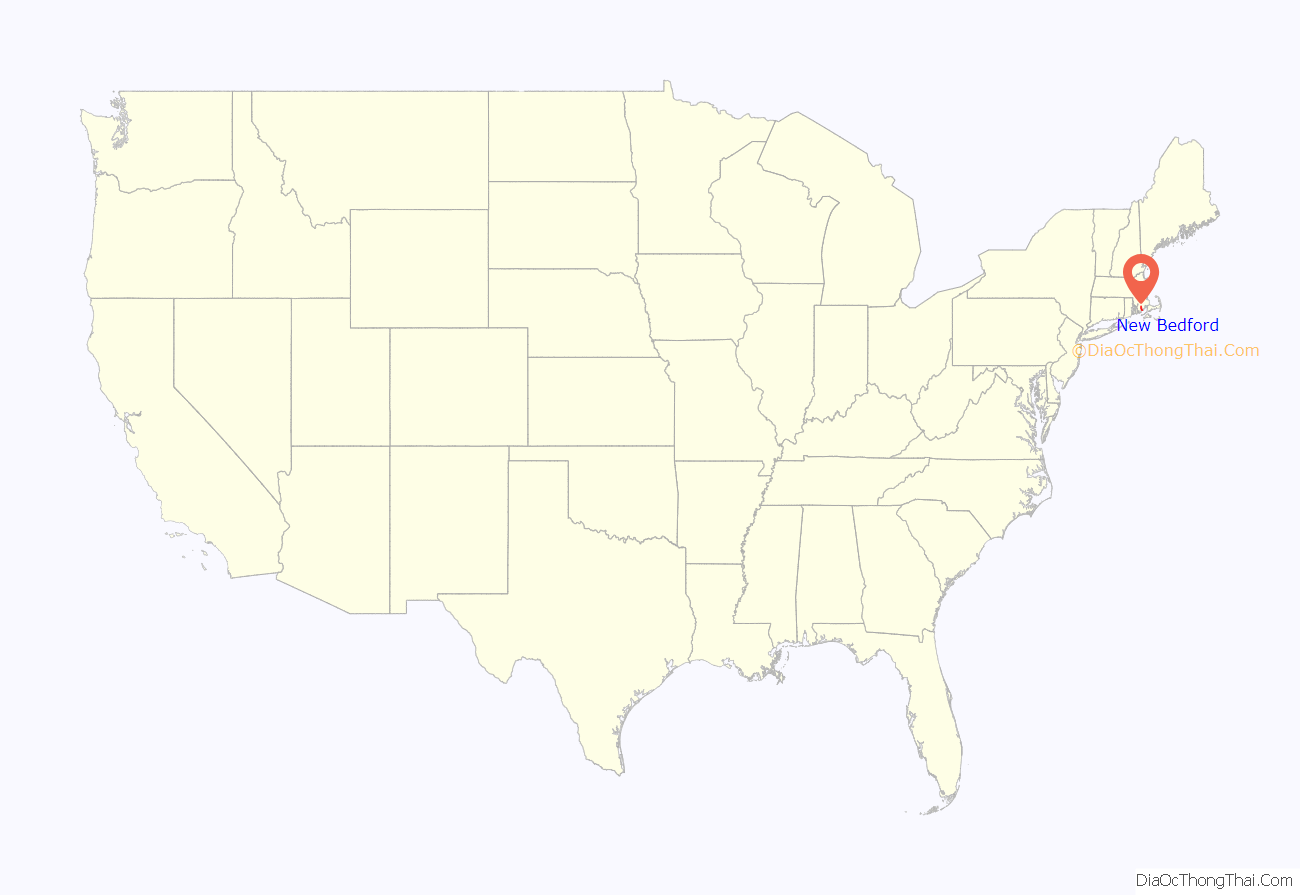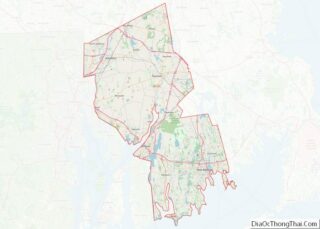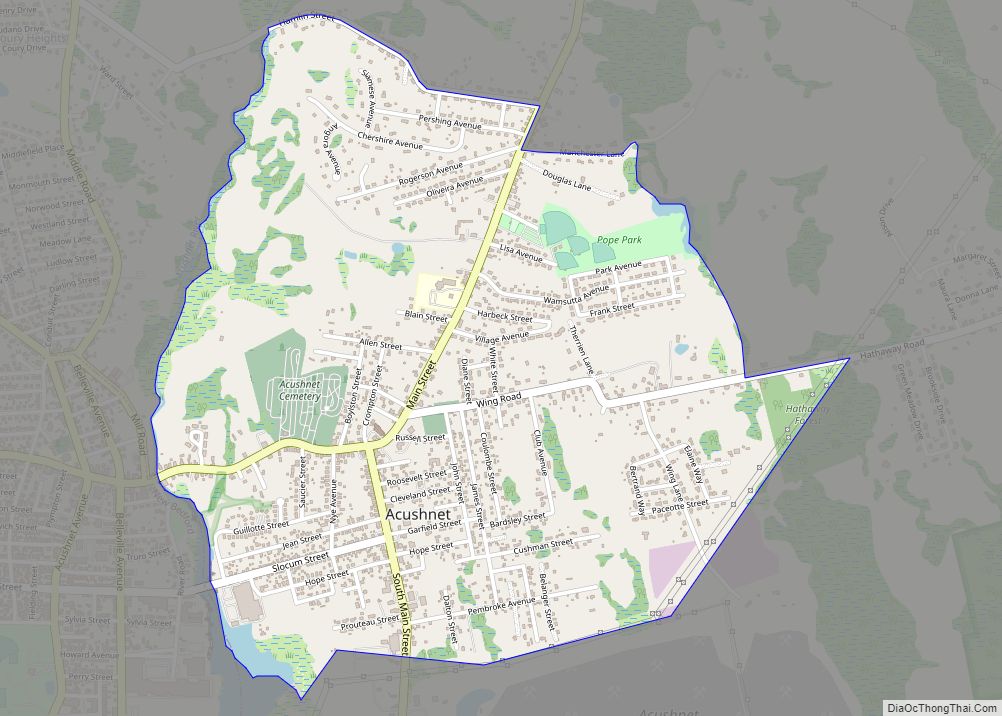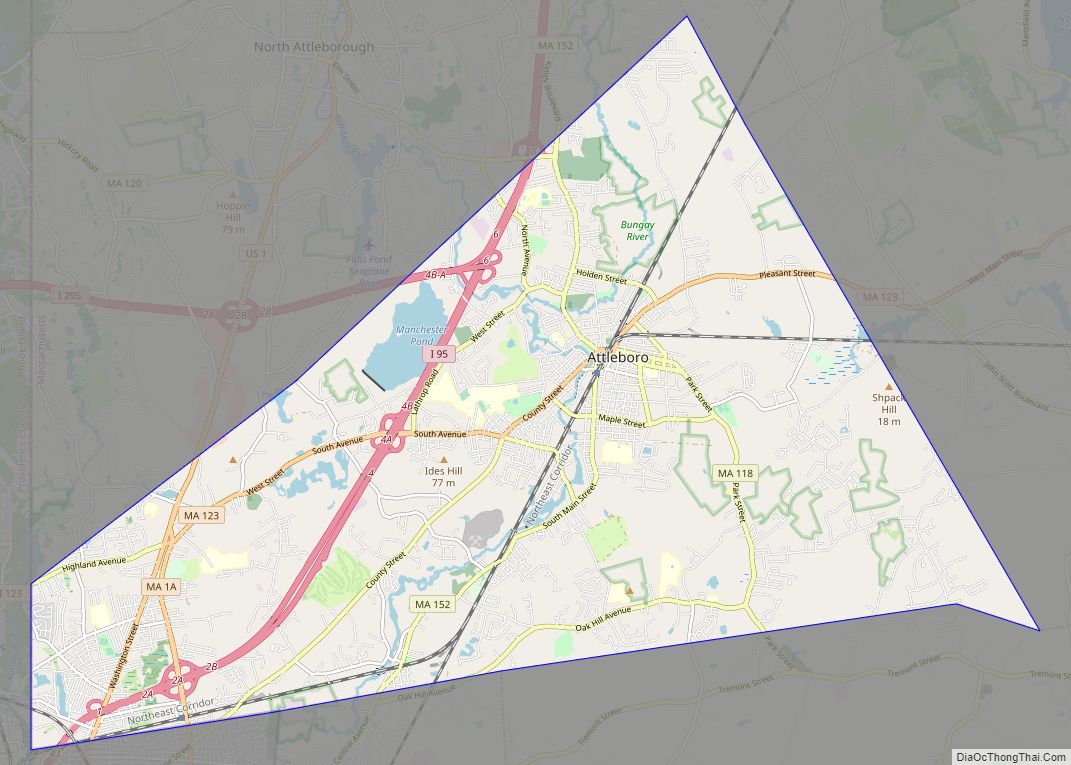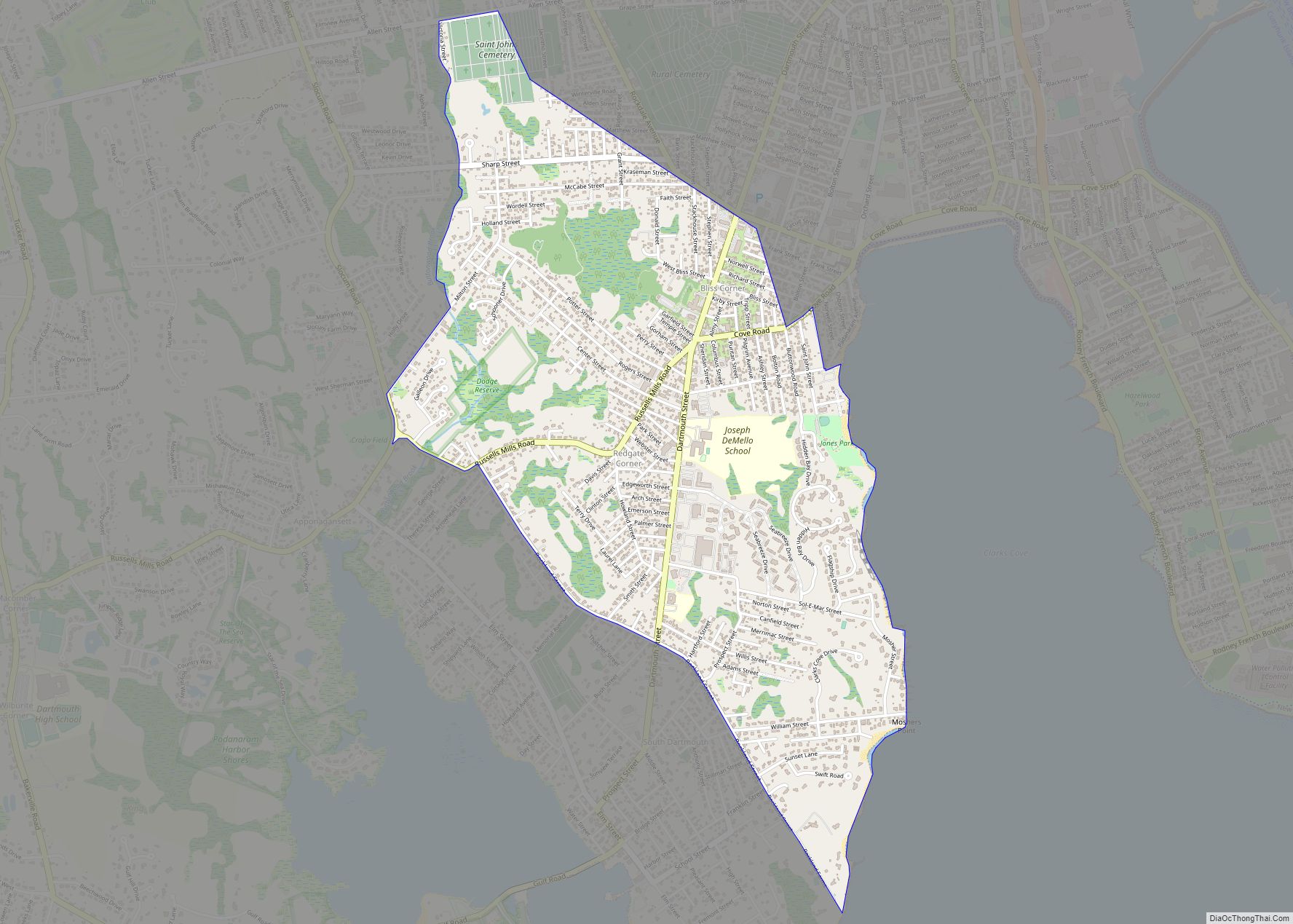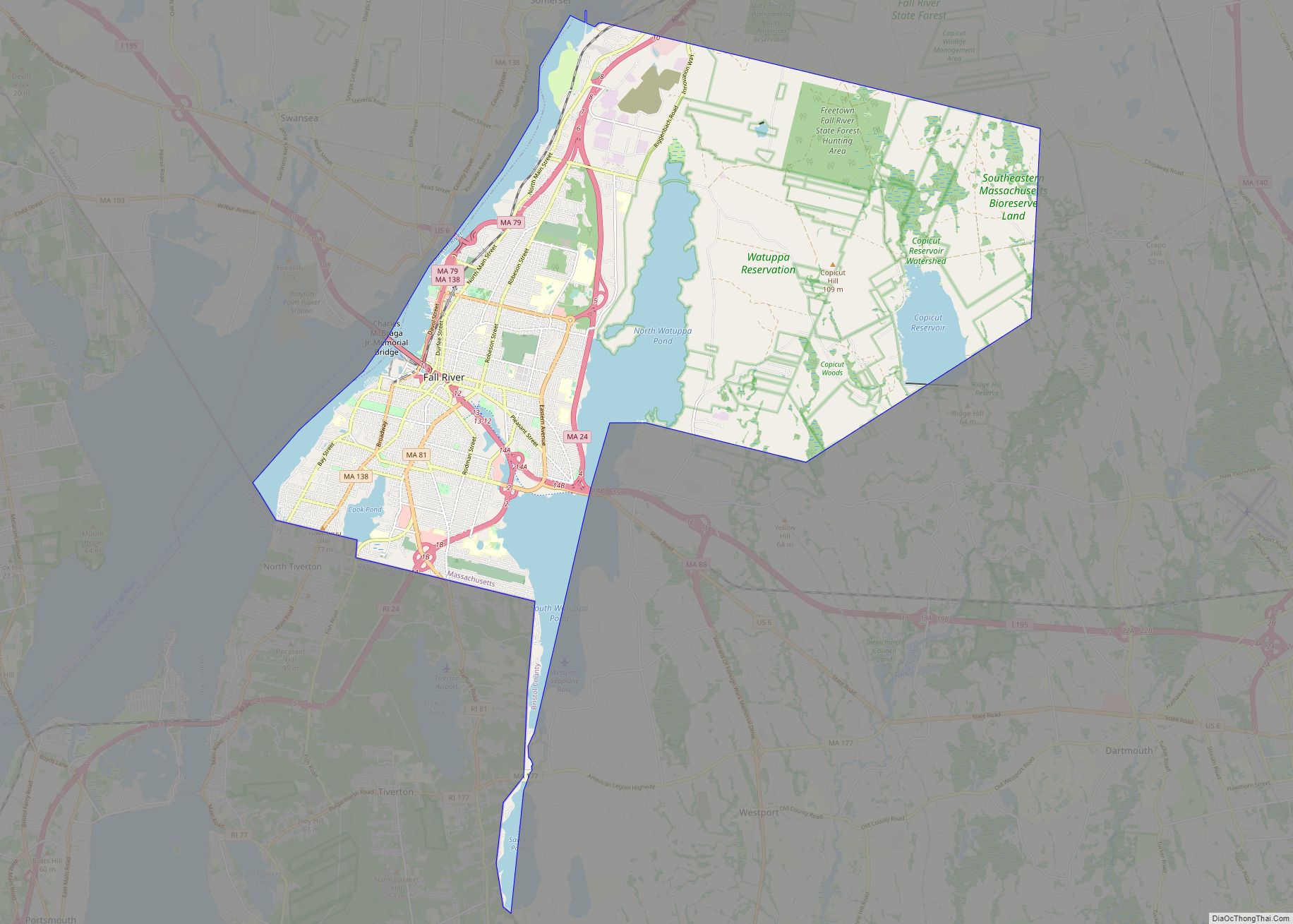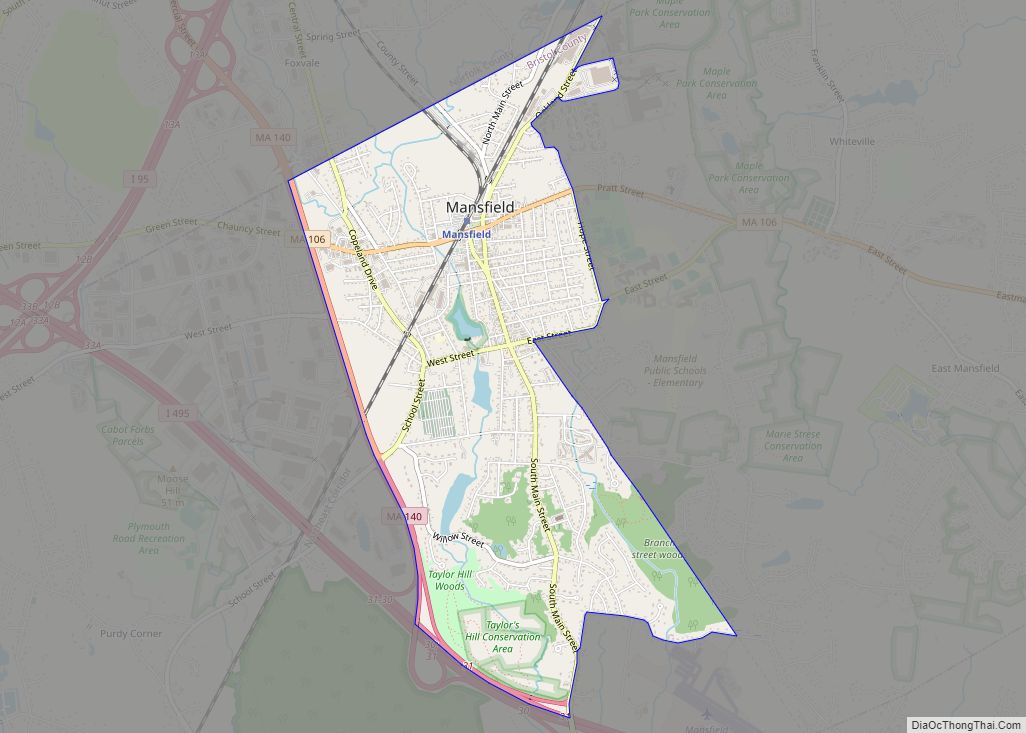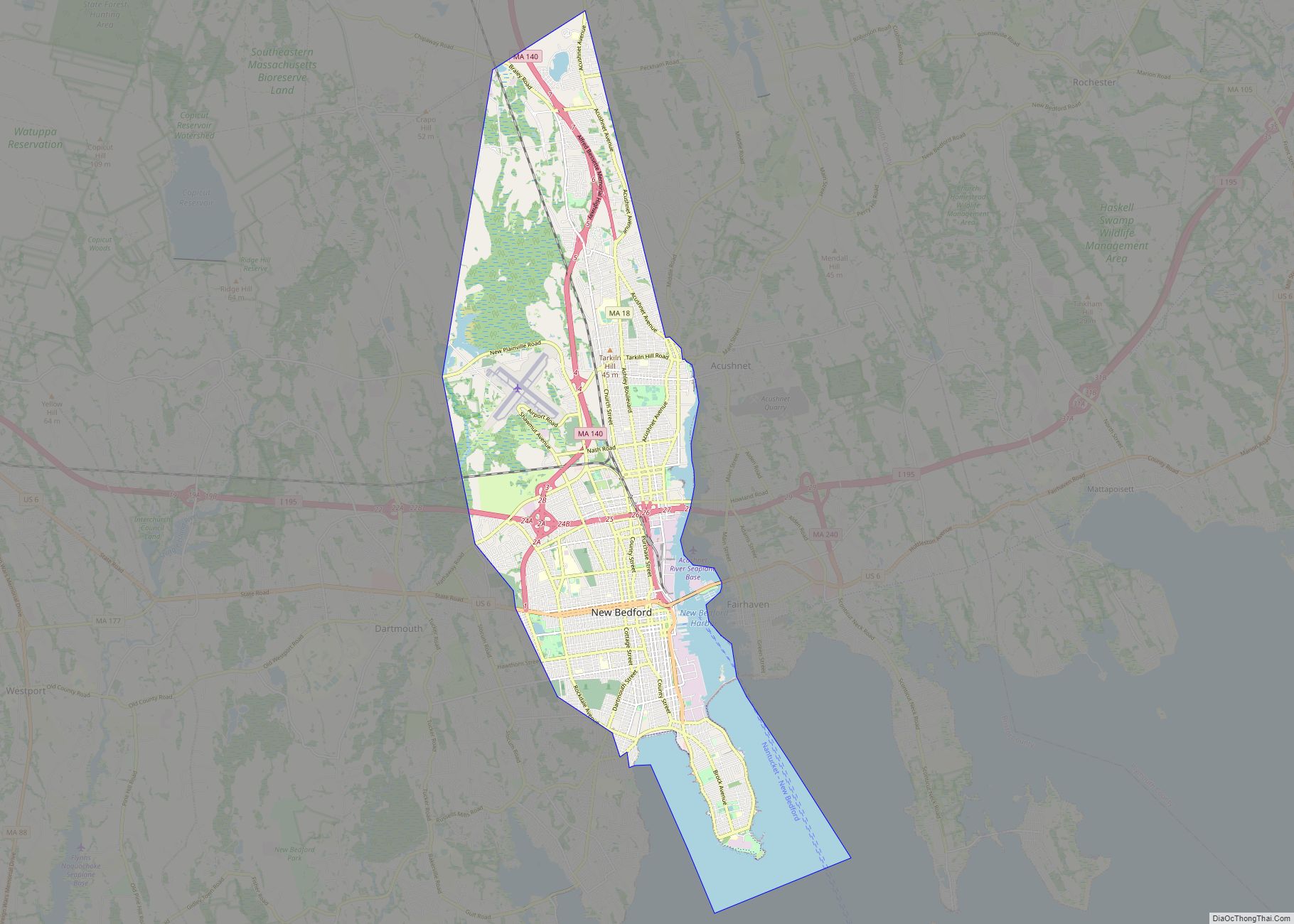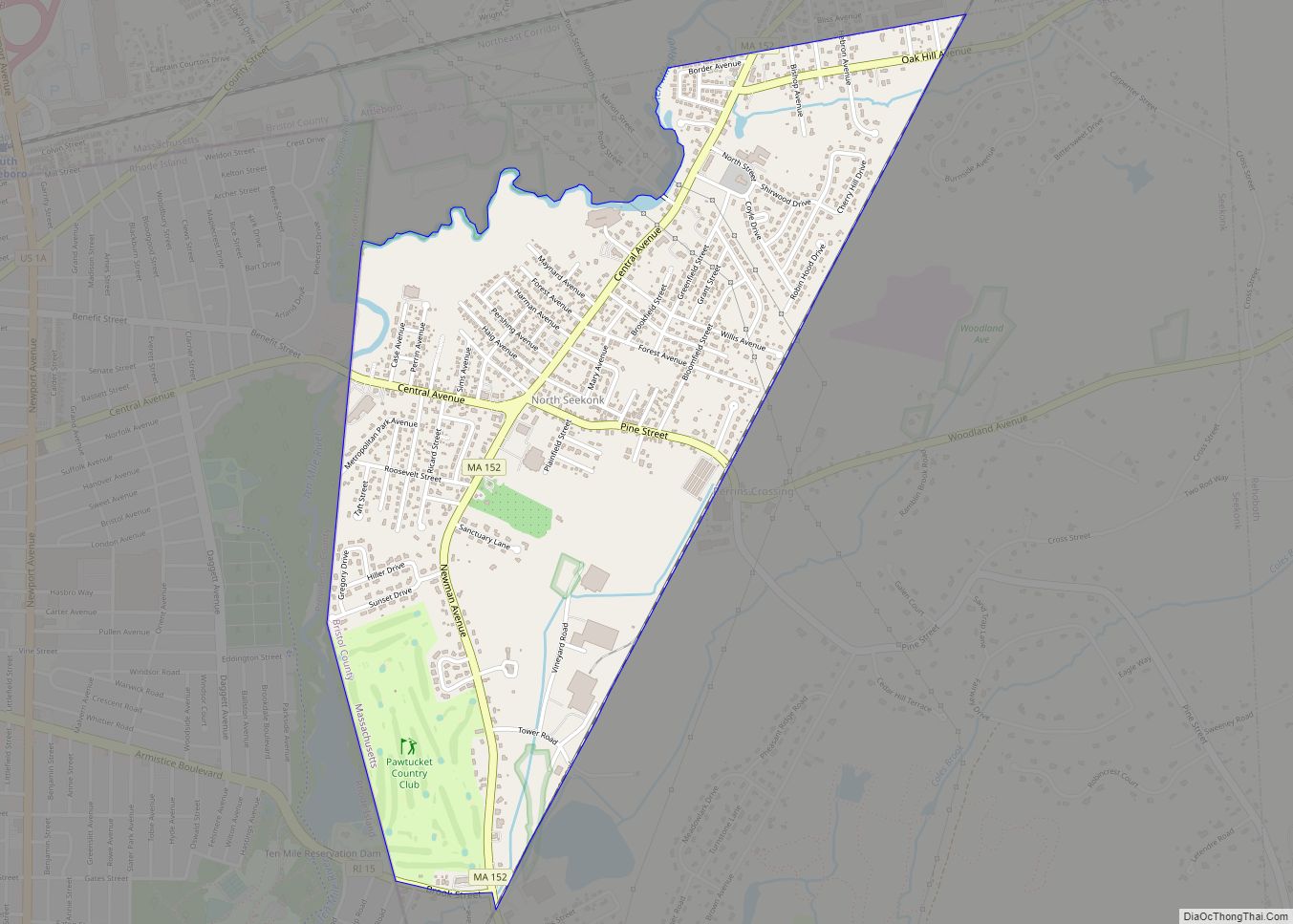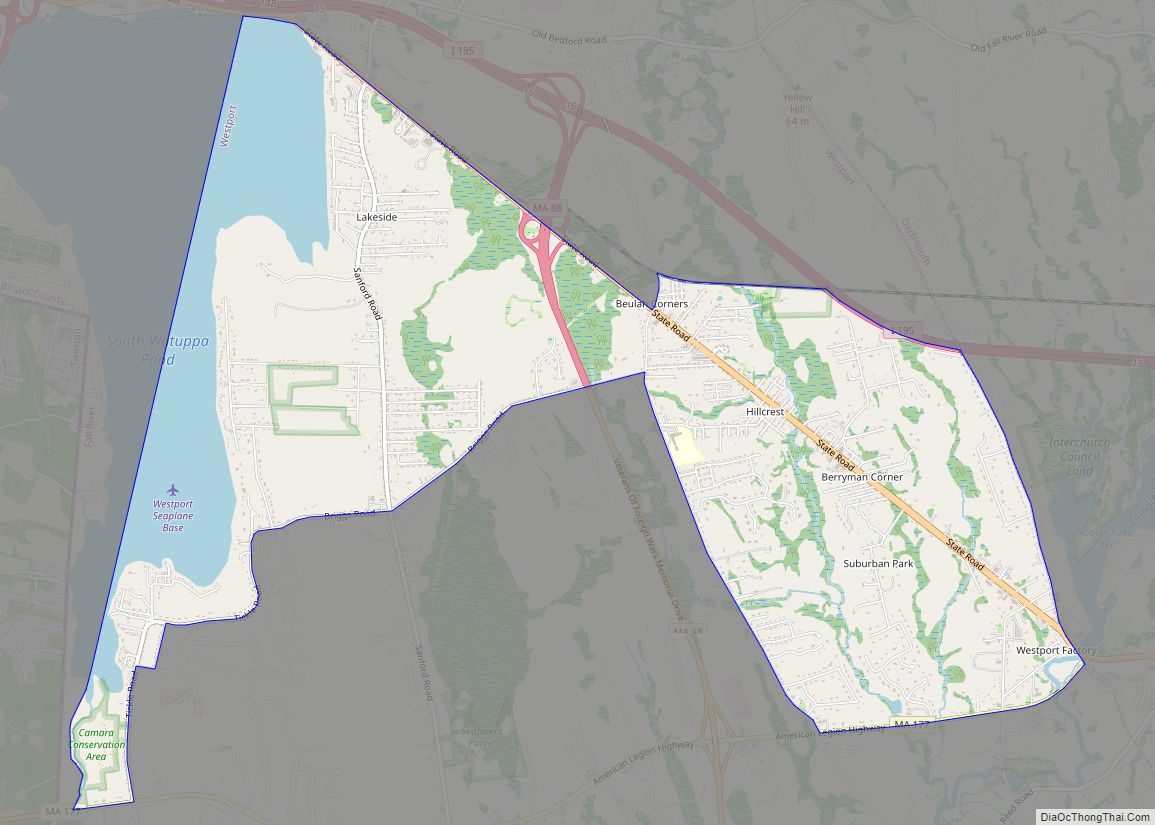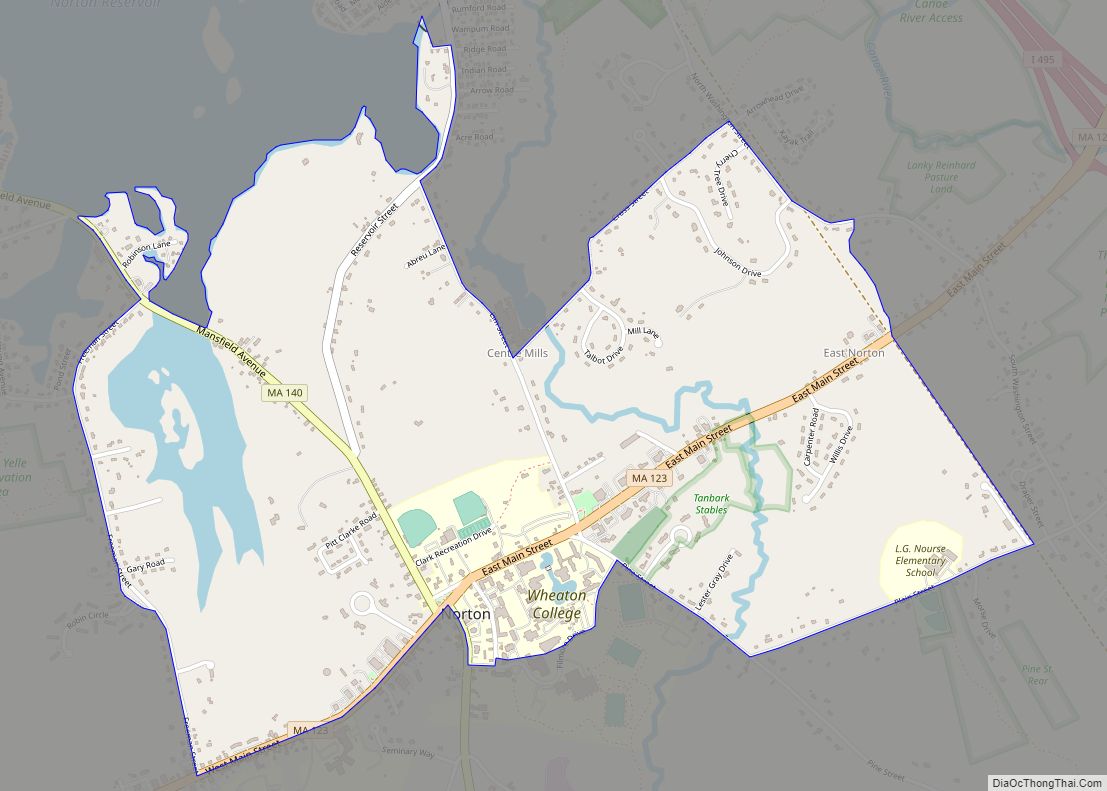New Bedford (Massachusett: Accushnet) is a city in Bristol County, Massachusetts, United States. It is located on the Acushnet River in what is known as the South Coast region. Up through the 17th century, the area was the territory of the Wampanoag Native American people. English colonists bought the land on which New Bedford would later be built from the Wampanoag in 1652, and the original colonial settlement that would later become the city was founded by English Quakers in the late 17th century. The town of New Bedford itself was officially incorporated in 1787.
During the first half of the 19th century, New Bedford was one of the world’s most important whaling ports. At its economic height during this period, New Bedford was the wealthiest city in North America per capita. New Bedford was also a center of abolitionism at this time. The city attracted many freed or escaped African-American slaves, including Frederick Douglass, who lived there from 1838 until 1841. The city also served as a setting in Herman Melville’s 1851 novel Moby-Dick. From 1876 to 1900, New Bedford served as the initial home port for the Revenue Cutter School of Instruction, the precursor of the United States Coast Guard Academy.
At the 2020 U.S. census, New Bedford had a population of 101,079, making it the state’s ninth-largest city and the largest of the South Coast region. The city is also known for its high concentration of Portuguese Americans. New Bedford remains known for its fishing fleet and accompanying seafood industry, which as of 2019 generated the highest annual value of any fishing port in the United States. The city is also home to the New Bedford Whaling Museum and New Bedford Whaling National Historical Park.
| Name: | New Bedford city |
|---|---|
| LSAD Code: | 25 |
| LSAD Description: | city (suffix) |
| State: | Massachusetts |
| County: | Bristol County |
| Elevation: | 50 ft (15 m) |
| Total Area: | 24.13 sq mi (62.50 km²) |
| Land Area: | 20.00 sq mi (51.80 km²) |
| Water Area: | 4.13 sq mi (10.70 km²) |
| Total Population: | 102,882 |
| Population Density: | 5,053.70/sq mi (1,951.25/km²) |
| ZIP code: | 02740, 02744, 02745, 02746 |
| Area code: | 508 / 774 |
| FIPS code: | 2545000 |
| GNISfeature ID: | 0613714 |
| Website: | www.newbedford-ma.gov |
Online Interactive Map
Click on ![]() to view map in "full screen" mode.
to view map in "full screen" mode.
New Bedford location map. Where is New Bedford city?
History
Before the 17th century, the lands along the Acushnet River were inhabited by the Wampanoag Native Americans, who had settlements throughout southeastern Massachusetts and Rhode Island, including Martha’s Vineyard and Nantucket. Their population is believed to have been about 12,000.
On May 15, 1602, English explorer Bartholomew Gosnold in the ship Concord landed on Cuttyhunk Island while exploring New England. From there, he explored Cape Cod and the neighboring areas, including the site of present-day New Bedford. Gosnold left and settled in the Jamestown Colony of Virginia.
Old Dartmouth
In 1652, English colonists purchased Old Dartmouth—a region of 115,000 acres (470 km) that is now Dartmouth, Acushnet, New Bedford, Fairhaven, and Westport—in a treaty between the Wampanoag, represented by Chief Ousamequin (Massasoit) and his son Wamsutta, and John Winslow, William Bradford, Myles Standish, Thomas Southworth, and John Cooke. While the Europeans considered themselves full owners of the land through the transaction, the Wampanoag have disputed this claim because the concept of land ownership—in contrast with hunting, fishing, and farming rights—was a foreign concept to them.
Members of the Religious Society of Friends, also known as Quakers, were among the early European settlers on the South Coast. They had faced persecution in the Puritan communities of Plymouth Colony and Massachusetts Bay Colony; the latter banned the Quakers in 1656–1657. When the Massachusetts Bay Colony annexed the Plymouth Colony in 1691, Quakers already represented a majority of the population of Old Dartmouth. In 1699, with the support of Peleg Slocum, the Quakers built their first meeting house in Old Dartmouth, where the Apponegansett Meeting House is now located.
At first, the Old Dartmouth territory was devoid of major town centers, and instead had isolated farms and small, decentralized villages, such as Russells’ Mills. One reason for this is that the inhabitants enjoyed their independence from the Plymouth Colony and they did not want the Plymouth court to appoint them a minister.
At this time, the economy primarily ran on agriculture and fishing. The availability of land attracted many Quakers and Baptists from Newport and Portsmouth in Rhode Island, as well as more waves of Puritan migration.
The rising European population and increasing demand for land led the colonists’ relationship with the indigenous inhabitants of New England to deteriorate. European encroachment and disregard for the terms of the Old Dartmouth Purchase led to King Philip’s War in 1675. In this conflict, Wampanoag tribesmen, allied with the Narragansett and the Nipmuc, raided Old Dartmouth and other European settlements in the area. Europeans in Old Dartmouth garrisoned in sturdier homes—John Russell’s home at Russells Mills, John Cooke’s home in Fairhaven, and a third garrison on Palmer Island.
New Bedford
A section of Old Dartmouth near the west bank of the Acushnet River, originally called Bedford Village, was officially incorporated as the town of New Bedford on February 23, 1787, after the American Revolutionary War. The name was suggested by the Russell family, who were prominent citizens of the community. The Dukes of Bedford, a leading English aristocratic house, also bore the surname Russell. (Bedford, Massachusetts, had been incorporated in 1729; hence “New” Bedford.)
The late 18th century was a time of growth for the town. A small whale fishery developed, as well as modest international trade. In the 1760s, between the Seven Years’ War and the American Revolution, shipwrights, carpenters, mechanics, and blacksmiths, settled around New Bedford harbor, creating a skilled and comprehensive maritime community.
New Bedford’s first newspaper, The Medley (also known as the New Bedford Marine Journal), was founded in 1792. On June 12, 1792, the town set up its first post office. William Tobey was its first postmaster. The construction of a bridge (originally a toll bridge) between New Bedford and present-day Fairhaven in 1796 also spurred growth. (Fairhaven separated from New Bedford in 1812, forming an independent town that included both present-day Fairhaven and present-day Acushnet.)
Whaling City
Nantucket had been the dominant whaling port, though the industry was controlled by a cartel of merchants in Boston, Newport, and Providence. In the 1760s, Nantucket’s most prominent whaling families moved to New Bedford, refining their own oil and making their own premium candles.
The American Revolutionary War completely paralyzed the whaling industry. British forces blockaded American ports and captured or destroyed American commercial ships; they even marched down King’s Street in New Bedford (defiantly renamed Union Street after the Revolution) and set businesses on fire.
Nantucket was even more exposed, and the physical destruction, frozen economy, and import taxes imposed after the war obliterated previous fortunes. New Bedford also had a deeper harbor and was located on the mainland. As a result, New Bedford supplanted Nantucket as the nation’s preeminent whaling port, and so began the Golden Age of Whaling. William Rotch (owner of the Dartmouth of the Boston Tea Party) and Samuel Rodman were important Quaker businessmen in the whaling industry.
After the War of 1812’s embargo was lifted, New Bedford started amassing a number of colossal, sturdy, square-rigged whaling ships, many of them built at the shipyard of Mattapoisett. The invention of on-board tryworks, a system of massive iron pots over a brick furnace, allowed the whalers to render high quality oil from the blubber. This allowed the whaling ships to go out to sea for as long as four years, processing their catch while at sea. Ships from New Bedford came back to port with barrels of oil, spermaceti, and occasionally ambergris.
Whaling dominated New Bedford’s economy for much of the century, and many families of the city were involved with it as crew and officers of ships. The Quakers remained prominent and influential in New Bedford throughout the whaling era. They brought religious values into their business models, promoting stability as well as prosperity, investing in infrastructure projects such as rail, and employing without discrimination. They established solid social and economic relationships with Boston, New York, and Philadelphia, integrating New Bedford into the urban northeastern economy.
Ten thousand men worked in the whaling industry. During this period, New Bedford’s population increased from approximately 4,000 in 1820 to about 24,000 in 1860. At the height of the whaling industry in 1857, the harbor hosted 329 vessels worth over $12 million, and New Bedford became the richest city per capita in North America.
On March 18, 1847, the town of New Bedford officially became a city; Abraham Hathaway Howland was elected its first mayor.
Land of Opportunity
The Quakers of New Bedford applied their principles of egalitarianism and community-building in their businesses. On the boats, at the docks, at the factories, or in the shops—British, Wampanoag, Cape Verdean, Azorean, Irish, and West African hands found work in New Bedford.
New Bedford also became one of the first fermentation centers of abolitionism in North America, and an important stop on the Underground Railroad. Many people were attracted by New Bedford’s relatively open-minded atmosphere. For example, Paul Cuffe—an Ashanti-Wampanoag Quaker and self-made tycoon—among several other remarkable achievements earned black property owners in New Bedford the right to vote decades before Abraham Lincoln even signed the Emancipation Proclamation. Lewis Temple, an African-American blacksmith, invented the Temple toggle iron, which was the most successful harpoon design. Frederick Douglass, the famous social reformer and orator, also found amnesty in New Bedford and worked at the wharf for three years.
Whaling decline
The whaling industry went into decline after the 1859 discovery of petroleum in Pennsylvania. Each decade since then saw a gradual decrease in whaling work, activity, and revenue. During the Civil War, the Confederacy engaged in commerce raiding with ships such as the Alabama, the Florida, and the Shenandoah, trying to attack the Yankee whaling industry and sabotage the US economy. Additionally, the US federal government bought several inactive whalers, filled them with stones, sand, and dirt, and towed them to Charleston, South Carolina, where the Union Navy sank what became known as the Stone Fleet in an unsuccessful attempt to blockade the Confederate bay. Along with the poor business and low whale populations, this dealt a potent blow to a failing industry.
Textile industry
In the midst of this decline, greater New Bedford’s economy became more dependent on the textile industry, which began to eclipse the whaling industry in the late 19th century. The mills grew and expanded constantly, eventually comprising multiple sites along the Acushnet River. In 1875 alone, the Wamsutta Mills processed 19,000 bales of cotton into 20 million yards of cloth, which had a wholesale value comparable to that of the entire whaling catch, and continued to produce over 20 million yards of cloth yearly after 1883. The Wamsutta Mills remained the world’s largest weaving plant until 1892.
The textile mills redefined wealth in New Bedford, and gave birth to a prosperity greater than that of the whaling industry. New Bedford, funded by industrial fortunes, developed a thriving art scene. The Mount Washington Glass Company (which later became Pairpoint) crafted works of glass and silver for the newly affluent class, and examples of these works can be seen today on the second floor of the New Bedford Whaling Museum.
In the 1920s, local employers came under competitive pressure from new textile factories in the low-wage South. In April 1928 their demand for a 10 percent across the board cut in wages was met was met with strike action. After considerable controversy control of the large-scale work stoppage passed from the Communist-led Textile Mill Committee (TMC) to sundry craft unions affiliated with the American Federation of Labor who, agreeing to a five percent wage cut, ended the strike in October. Wage reductions were not enough to arrest the long-term competitive decline of the local textile industry.
- Photographs taken by Lewis Hine for the NCLC.
Immigration
Until 1800, New Bedford and its surrounding communities were, by and large, populated by Protestants of English, Scottish, Welsh, and Dutch origin. During the first half of the 19th century many Irish people came to Massachusetts. In 1818, Irish immigrants established the Catholic mission that built St. Mary’s Church. Later in that century, immigrants from Portugal and its colonial possessions in the Atlantic—Cape Verde, the Azores, and Madeira—began arriving in New Bedford and the surrounding area, attracted by jobs in the whaling industry; many had family members who had worked on whaling ships. As the Portuguese community began to increase in population, it established the first Portuguese parish in the city, St. John the Baptist (1871). French Canadians also secured a foothold in New Bedford at about the same time, and they built the Church of the Sacred Heart in 1877.
Similarly, Polish immigrants began arriving in the late 19th century and established the parish of Our Lady of Perpetual Help in 1903. A number of Jewish families, arriving in the late 19th century, were active in the whaling industry, selling provisions and outfitting ships. During the years leading up to the First World War, a sizable eastern-European Jewish community joined them in New Bedford. Some became prominent merchants and businessmen, mainly in textiles and manufacturing.
Modern history
Fishing and manufacturing continue to be two of the largest businesses in the area, and healthcare has become a major employer. The three largest single employers based in New Bedford are Southcoast Hospitals Group, one of the top ten employers in Massachusetts (healthcare), Titleist (golf clubs, balls, apparel, manufacturing), and Riverside Manufacturing (apparel manufacturing).
According to a 2001 study by the University of Massachusetts Dartmouth Center for Policy Analysis, the three largest employment sectors in the Greater New Bedford area (the area includes New Bedford and Acushnet, Dartmouth, Fairhaven, Freetown, Lakeville, Marion, Mattapoisett, Rochester, and Wareham) were as follows: services (26% of total employment); wholesale trade (22%); manufacturing (19%). The largest industries by employment in the area were as follows: health services, eating and drinking places, wholesale trade, food stores, and social services.
In 2002, the city received $61,194,358 in taxation revenue, $44,536,201 in local receipts, and $12,044,152 classified as other available.
In 2005 the unemployment rate was 7.3%, having dropped throughout the 1990s from 12.5% to 5.3% in 2000, and then having risen to 10.4% in 2003. By 2009, in the midst of the economic crisis of the era, the unemployment rate got as high as 12.4%.
In 2005, the city received $104,925,772 for education, and $22,755,439 for general government from the State of Massachusetts.
In 2016, the city hopes its proximity to Massachusetts’ southern coastline will allow it to become a center for the growing wind energy market. Three companies, OffshoreMW, Deepwater Wind, and DONG Energy, have leased portions of New Bedford’s Marine Commerce Terminal for the staging of turbines and platforms.
Establishments
In 1847, the New Bedford Horticultural Society was begun by James Arnold.
The Ash Street Jail, which houses inmates from Bristol County, is located in New Bedford. It opened in 1829 and is the oldest continuously operating jail in the United States.
Fort Taber and Fort Rodman (also called the “Fort at Clark’s Point”) were built during the American Civil War and are now in Fort Taber Park. Both forts are often called Fort Taber, including in some references.
New Bedford Road Map
New Bedford city Satellite Map
Geography
New Bedford is located at 41°39′06″N 70°56′01″W / 41.651803°N 70.933705°W / 41.651803; -70.933705 (41.651803, −70.933705). According to the United States Census Bureau, the city has a total area of 24.1 square miles (62.5 km). Of the total area, 20.0 square miles (51.8 km) is land, and 4.1 square miles (10.7 km), or 17.13%, is water. New Bedford is a coastal city, a seaport, bordered on the west by Dartmouth, on the north by Freetown, on the east by Acushnet and Fairhaven, and on the south by Buzzards Bay. From New Bedford’s northern border with Freetown to the Buzzards Bay coast at Clark’s Point the distance is approximately 14 miles (23 km). Across New Bedford east to west is a distance of about 2 miles (3.2 km). The highest point in the city is an unnamed hill crossed by Interstate 195 and Hathaway Road west of downtown, with an elevation greater than 180 feet (55 m) above sea level.
The Port of New Bedford, also known as New Bedford Harbor, a body of water shared with Fairhaven, is actually the estuary of the Acushnet River where it empties into Buzzards Bay. The river empties into the bay beyond Clark’s Point, the southernmost point of the city. To the west of Clark’s Point is Clark’s Cove, which extends landward approximately one and a half mile from the bay. Just south of Palmer’s Island, beginning near Fort Phoenix in Fairhaven, lies a two-mile-long hurricane barrier, constructed in the 1960s to protect the inner harbor where the fishing fleet anchors. Along with Palmer’s Island, the city also lays claim to Fish Island and Pope’s Island. Between these two islands lies one of the three sections, the central section, of the New Bedford-Fairhaven Bridge. The central span, a swing bridge, connects the two islands as well as allowing boats and ships passage to the upper harbor. Two conventional bridges connect each of the islands to the nearest mainland, Fish Island to New Bedford and Pope’s Island to Fairhaven. In addition to the harbor, there are several small brooks and ponds within the city limits.
Parks
There are several parks and playgrounds, some with splash pads, scattered throughout the city, with the first four being primary parks:
- Abolition Row Park
- Acushnet Cedar Swamp State Reservation
- Allen C. Haskell Public Gardens
- Ashley Park
- Baby Kenney Tot Lot
- Brooklawn Park
- Buttonwood Park
- Captain Jack Peterson Dog Park
- Clasky Common Park
- Custom House Square
- Flora B. Pierce Nature Trail
- Fort Rodman/Taber Park
- Hazelwood Park
- Marine Park at Pope’s Island
- New Bedford Covewalk
- New Bedford Whaling National Historical Park
- Ricketson’s Nature Trail
- River’s End Park
- Riverside Park
- Roberto Clemente Park
- Ross C. Mathieu Nature Trail
- Victory Park Community Gardens
Climate
New Bedford has a cooler than normal version of a humid subtropical climate that in many aspects resembles a humid continental one, but with slightly milder winters. In spite of being influenced by continental winds with large differences between seasons, temperatures are somewhat moderated compared to areas farther inland. There is high precipitation year-round, with winter being split between rainfall and snowfall.
See also
Map of Massachusetts State and its subdivision: Map of other states:- Alabama
- Alaska
- Arizona
- Arkansas
- California
- Colorado
- Connecticut
- Delaware
- District of Columbia
- Florida
- Georgia
- Hawaii
- Idaho
- Illinois
- Indiana
- Iowa
- Kansas
- Kentucky
- Louisiana
- Maine
- Maryland
- Massachusetts
- Michigan
- Minnesota
- Mississippi
- Missouri
- Montana
- Nebraska
- Nevada
- New Hampshire
- New Jersey
- New Mexico
- New York
- North Carolina
- North Dakota
- Ohio
- Oklahoma
- Oregon
- Pennsylvania
- Rhode Island
- South Carolina
- South Dakota
- Tennessee
- Texas
- Utah
- Vermont
- Virginia
- Washington
- West Virginia
- Wisconsin
- Wyoming
